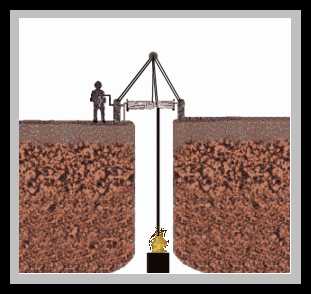PONTYPOOL GLYN PITS
Fire Baskets

Because natural ventilation was, to say the least, extremely inefficient, other methods were used, such as falling water, by which air was entrained in water allowed to fall into the down-cast shaft, the result was to cause a current of air to enter the mine, and also to cool the air in the down-cast shaft, giving a similar effect, although giving less volume. However, this method would only be used in small mines, usually without much in the way of pumping equipment, and would, therefore, have depended on good drainage for the water either through an 'Adit' (A small drainage tunnel) or through natural drainage. Furnaces, already studied, and 'Fire-Baskets' were also used. These were simple 'Braziers', or large baskets of fire suspended in the up-cast shaft from an overhead framework or simple cantilever bracket by a chain connected to a 'Wind-lass' or small hand-operated winch. This used the principle of hot air being lighter than cold, thus allowing the cold air in the down-cast shaft to displace the lighter heated air in the up-cast. These 'Fire-buckets' were usually lowered into the shaft at the end of a shift, and removed at the commencement of work the following day, by which time the shaft walls would have been warmed, thus helping to circulate the air through the mine, plus the air would also have been given a certain amount of momentum. It will be obvious that such methods would not normally have been used in a very 'Gassy' mine.